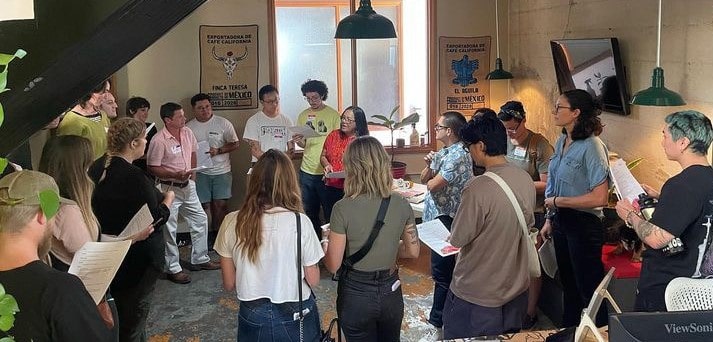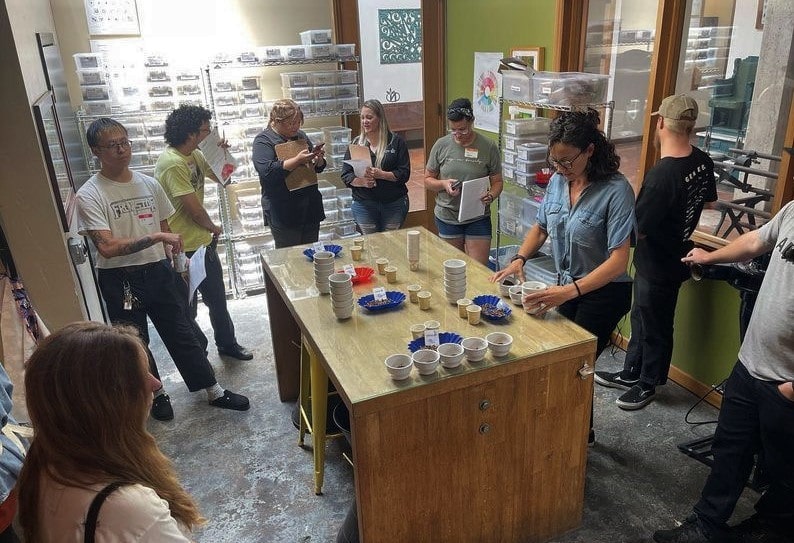Last week our San Diego team, in collaboration with Nibble Chocolate, hosted a coffee cupping and chocolate tasting. This event was inspired by conversations in the cupping lab around our taste descriptions. As sensory professionals, we work constantly to identify our subjective perceptions as precisely as possible. For example, chocolate is a common coffee descriptor, yet there is quite a difference between milk chocolate, cocoa powder, and a single origin 70% dark chocolate, so it is more helpful to specify which one we have detected. Our cuppers refine this skill on a daily basis, uniting as a team to compare their individual experiences in order to provide accurate and relevant notes. Given those notes are ultimately for our customers, we thought sharing this calibration exercise directly with them would be valuable, and so the idea was born.
For this event, we partnered with Nibble Chocolate, a local San Diego company that imports, roasts and processes cocoa, producing small batch chocolates. The range of their offerings allowed us to curate a diverse flight with samples differing not just in cocoa percentages, but also in countries of origin. Dana Andrews, Pablo Lara and Shaa’ista Sabir selected five chocolates to illustrate the range of chocolate flavors commonly found in coffee.
With Central American coffees arriving steadily over the past few months, we had a range of coffees to choose from. To minimize variables and present classically chocolate-forward profiles, we decided to present a range of offerings from Guatemala. Focusing on Guatemala provided an additional opportunity to showcase our long-standing relationships with several Cooperatives across the country. Erika Hernandez, Sustainable Green Coffee Sourcing for InterAmerican San Diego, provided a brief overview of the history of those relationships, along with harvest updates and special project information for each organization. Following Erika’s presentation, Jennifer from Nibble Chocolate educated the group on chocolate processing and roasting.

Erika Hernandez presented a history of our relationships with several cooperatives as well as harvest updates for each.
Subsequently, attendees moved into two cupping spaces for a shared sensory activity. Participants analyzed the fragrance and aroma of both the coffee and the chocolate. Then, they tasted the coffee when it was hot and warm, using SCA cupping protocols. On the final pass, participants were invited to finally taste the chocolates, taking separate notes for comparison. The result: a focused analysis of the unique chocolate profiles of each coffee, highlighted by the complementary pairing of chocolate.
The Pairings
Guatemala Santa Rosa Los Alamos / Mexico 70%
Orange, nutty aroma, chocolate cake mix, buttery / Creamy, buttery
Guatemala Guaya’b Fairtrade Organic / Brazil 72%
Lemon, almond, anise, milk chocolate / Malt, nutty, creamy
Guatemala Maya Ixil Avelina Fairtrade Organic / Madagascar 70%
Bright, red fruit, persimmon, floral / Honey, rangy, pistachio
Guatemala La Voz Atitlán Organic / Peru 85%
Brown sugar, lemon curd, lime juice, tangerine / Orange, lime
Guatemala Huehuetenango Pioneers / Raspberry 88%
Guava, candied fruit, juicy, berries, malic acidity / Bright acidity, red fruit
We are delighted for this opportunity to calibrate with our customers, showcase our long-standing relationships with Guatemalan Cooperatives, and dive into sensory analysis from a refreshing (and delicious) perspective. Thank you so much to everyone who came together to make this event possible, including Nibble Chocolate, Panchitas Bakery, and all our customers who joined in. •
